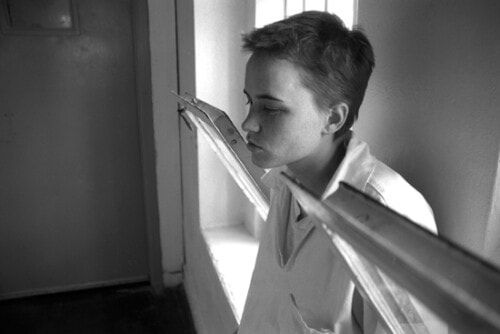The complex layering of the performative space that Baker traverses in its registers of the Imaginary, Symbolic, and Real can be discerned by way of comparison to Claude McKay’s inscription of the visual field as a network of possessing looks and gazes in “The Harlem Dancer”:
Applauding youths laughed with young prostitutes
And watched her perfect, half-clothed body sway;
Her voice was like the sound of blended flutes
Blown by black players upon a picnic day.
She sang and danced on gracefully and calm,
The light gauze hanging loose about her form;
To me she seemed a proudly swaying palm
Grown lovelier for passing through a storm.
Upon her swarthy neck black shiny curls
Luxuriant fell; and tossing coins in praise,
The wine-flushed, bold-eyed boys, and even the girls,
Devoured her shape with eager, passionate gaze;
But looking at her falsely-smiling face,
I knew her self was not in that strange place. 1
McKay’s English sonnet foregrounds the visual field of performance as a space of desire. During the course of the poem’s action, the viewing audience, the jazz club dancer, and the poet-observer variously emerge as perceiving subjects through the power to behold others as imaginary objects of desire. Possessing the gaze, however, is double-edged, as every act of possession risks being possessed by the regard of the other. Ownership of the gaze is further inflected by the mediating power of capital to reify the aura of the visible according to the exchange logic of the commodity fetish. 2 The poem begins with the paying audience made up of “applauding youths” who include not only the consumers of the primitivist spectacle but also those onlookers, the “young prostitutes,” who are themselves for hire. Their consumption of the spectacle hinges on the imaginary fantasy of the “perfect, half-clothed body” of the dancer that is itself fetishized by “the light gauze hanging loose about her form.” Desire in the poem is Dionysian and seizes “the wine-flushed, bold-eyed boys, and even the girls,” with intensities that exceed the conventions of compulsory heterosexuality. However “devoured” by the “eager, passionate gaze” of the onlookers, the dancer’s imaginary “shape” cannot redress the exchange of glances that undercuts the audience’s mastery of the spectacle. The jazz club audience must supplement its place in the scene’s visual economy by literally paying attention to the dancer, by “tossing coins” at the stage. Similarly, the poet-observer would possess the power of the gaze through the linguistic economy of figurative language, fixing the dancer as a “proudly swaying palm /Grown lovelier for passing through a storm.” “Looking,” however, on the mask of the dancer’s “falsely-smiling face,” the poet finds that his aesthetic voyeurism is deflected by the agency of the other’s gaze that, ultimately, falls outside the scopic frame of primitivist spectacle. The final cogito or “I” of the poem’s couplet presents a more radical perception of what the speaker “knew” to be “not in that strange place.” Entering the register of the Real, the witnessing “I” testifies to what escapes the desiring “eye” through a glance that renders the bizarre spectacle of “that strange place” even more uncanny.
Similar to its extralinguistic horizon in “The Harlem Dancer,” the return of the Real happens for Baker as the possessing address of the gaze whose origin lies outside the frame of both her own performative self-presentations and her audience’s imaginary expectations and desires. How may we begin to account for that spectral regard animating yet exceeding the “strange place” of her performance? 3 The force of Baker’s agency as a dancer, I would argue, negotiates a vexed legacy of loss and displacement similarly witnessed in Countee Cullen’s 1925 poem “Heritage,” written the same year as La Revue Nègre‘s staging. Cullen’s stylized aesthetic primitivism inscribes dance motifs that invoke Africa as a place of memory whose trauma nevertheless exceeds the imaginary registers of colonial fantasy. In the famous first line, “What is Africa to me?” Cullen invokes Africa as what Pierre Nora would theorize as a lieu de mémoire, 4 precisely in the sense that “All lieux de mémoire are,” as Nora writes, “objets mises en abîmes” (Nora 297). Such places, sites, and figures of memory are “mixed, hybrid, mutant” (Nora 295), where the memory “passed down by unspoken traditions, in the body’s inherent self-knowledge, in unstudied reflexes and ingrained memories” is “transformed by its passage through history, which is nearly the opposite” (Nora 289).
- Claude McKay, Selected Poems of Claude McKay (New York: Bookman Associates, 1953), 61.[↑]
- In Capital, Karl Marx defines the “mysterious character” of the commodity not according to its physical usefulness but rather in terms of the “fantastic form” of its exchange value shaped by its “autonomous” relations with other commodities. “I call this ‘fetishism,'” he writes, “which attaches itself to the products of labor as soon as they are produced as commodities.” Karl Marx, Capital, Vol. 1, trans. Ben Fowkes (New York: Vintage, 1977), 165. For a discussion of how commodity fetishism in the modern age of photography, film, advertising, and cinematic propaganda marks a decline in the visible aura of aesthetics, see Walter Benjamin, “The Work of Art in the Age of Mechanical Reproduction,” in Illuminations, trans. Harry Zohn. (London, Fontana, 1992), 211-244.[↑]
- For a discussion of the visual phenomenology of the traumatic Real experienced in the address or regard of the other’s possessing gaze, see Jacques Lacan, “The Split Between the Eye and the Gaze,” in The Four Fundamental Concepts of Psychoanalysis, Book XI, trans. Alan Sheridan (New York: W.W. Norton, 1998), 67-78.[↑]
- Pierre Nora, “Between Memory and History: Les Lieux de Mémoire,” History and Memory in African-American Culture, ed. Geneviève Fabre and Robert O’Meally (New York: Oxford University Press, 1994), 284-300.[↑]



